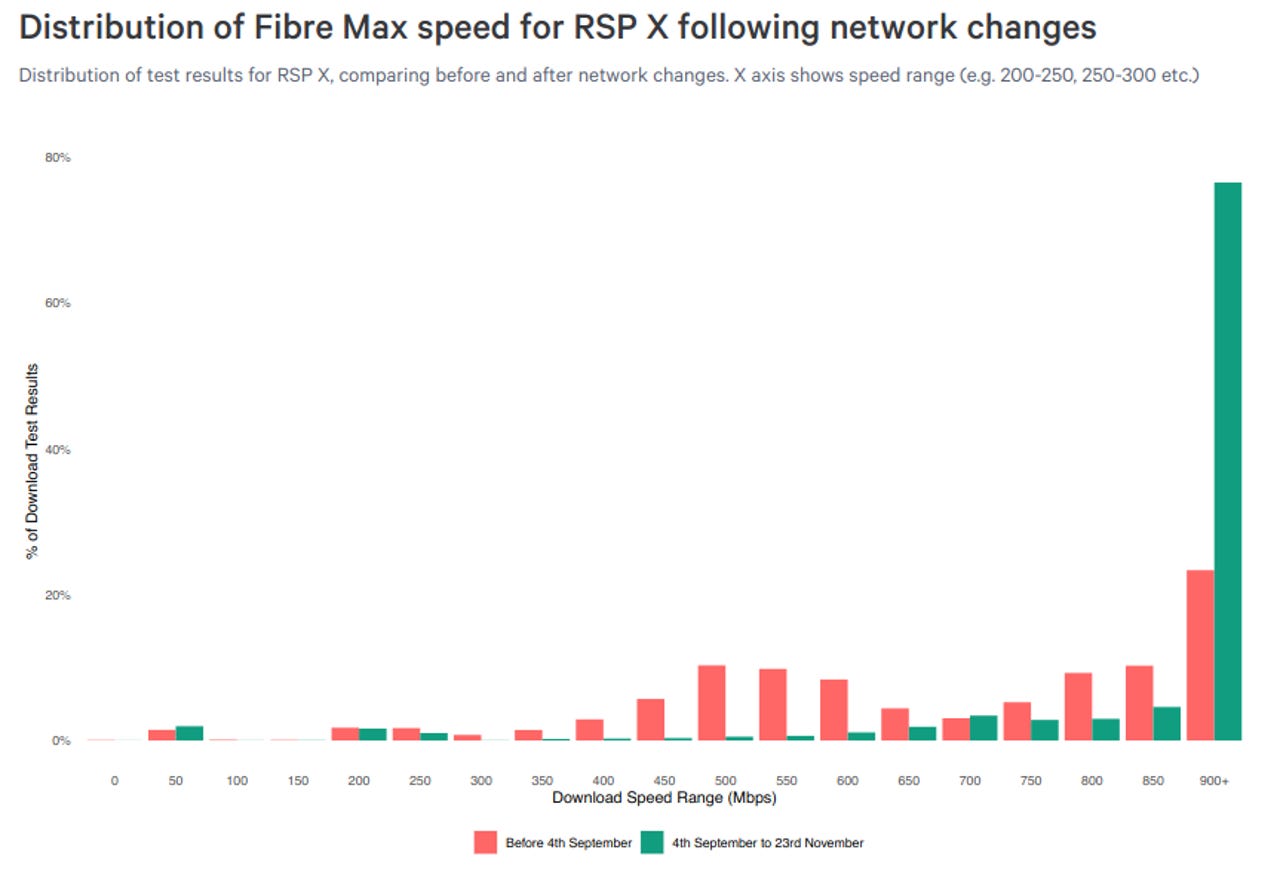Kiwi ISPs change network configs to see Fibre Max speeds improve to over 900Mbps


Provider of New Zealand's whitebox broadband speed testing solution, SamKnows, has worked with New Zealand wholesalers and retailers to boost the speeds of the nation's top broadband plan.
Fibre Max plans are based on a 1Gbps wholesale connection, which translates to around 940Mbps once SamKnows tests at the top of the networking stack -- a concept regulators in Australia have struggled with -- but typically, Fibre Max speed tests were averaging around 620Mbps.
In August, one of the two unnamed retailers SamKnows worked with found a higher than expected rate of packet discards, which particularly hit connections with relatively higher latency. After deploying a pair of changes at the start of September, Fibre Max tests in New Zealand are now recording 940Mbps with regularity.
"We believe this to be related to the packet loss issue driven by the burstiness parameters. When a TCP receiver detects packet loss, it will send a TCP retransmission request to the sender (in the form of a duplicate acknowledgement). Because the whiteboxes [with latency around 1-2 milliseconds] had a lower RTT, their retransmission requests reached the sender (the server) faster than the whiteboxes [with latency around 5-12 milliseconds], which allowed the missing data to be retransmitted faster, which ensured that throughput remained quite high," SamKnows wrote in a report on the issue [PDF].
"To be clear, the takeaway here should not be that 2.5ms RTT [round-trip time] is good and 10ms RTT is bad -- both are perfectly capable of sustaining 940Gbps throughput. But in the presence of packet loss or other impairments, the link with the lower RTT will likely recover faster."
After the changes were rolled out to ISP networks, tests on Netflix performed better, with the percentage hitting 800Mbps rising from 12.6% to 46%.
"This measure of download speed from Netflix is conducted over a single TCP connection, and is therefore much more sensitive to latency and packet loss than the regular SamKnows multi-TCP connection speed tests," the report said.
"Moreover, the traffic is served from the same Netflix caches that real Netflix users use, so there could be server-side congestion or other factors impairing performance that we are unaware of."
SamKnows also suspected an issue within Linux's TCP stack, but after upgrading the kernel on its test server, the issue that was causing "intermittent performance drops" disappeared.
Once the changes were deployed on the networks of two retailers, 76% of tests on Fibre Max lines hit over 900Mbps, while the percentage getting over 800Mbps has jumped from 46% to 84%.
The changes on the Fibre Max connections were made after SamKnows produced its latest Measuring Broadband report for the New Zealand Commerce Commission on broadband performance between July 24 and August 24.
The report contained many of the same findings as previous editions, particularly regarding slower speeds on the South Island.
To help get better measurements, a new server is being added in Christchurch to reduce latency from the Wellington server currently used.
Earlier in the week, the Commerce Commission said it finalised the rules by which Chorus could withdraw copper services in UFB areas, deciding that New Zealanders would have six months of notice.
"The fibre network build in New Zealand has been a significant success and we want to make sure the transition off the old copper network is as smooth as possible over the next few years," ComCom Telecommunications Commissioner Tristan Gilbertson said.
"We recognise that some consumers are nervous about this change and it's important to emphasise that Chorus can only stop supplying copper services where households can access the same services over the fibre network. In areas where fibre is not currently available Chorus must continue to supply copper services."
Chorus has yet to begin withdrawing copper, with the earliest date it can begin informing customers set for 1 March 2021, and subsequently, the first switch offs can only begin from September 1.
Updated at 4:30pm, 11 December 2020: added Commerce Commission's finalisation of Chorus copper withdrawal rules.
More from across the ditch
- Christchurch terrorist's radicalisation shows the limits of surveillance and censorship
- NZ adopts Google/Apple COVID-19 exposure notification tech for contact tracing
- Bank of NZ to launch text-to-Kiwi voice service
- Vocus set to IPO New Zealand arm
- 15 Asia Pacific countries sign world's largest free trade agreement
- Network transformation helped Spark seamlessly shift Kiwis into remote work